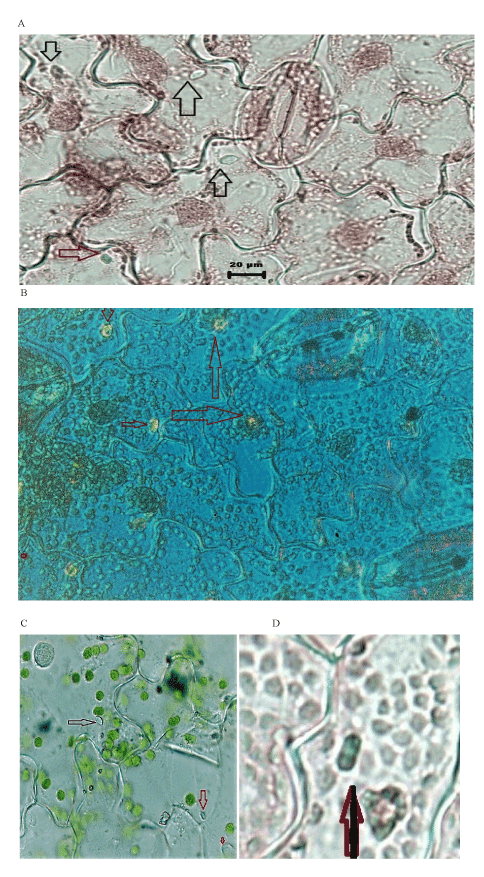Ophioglossum L. (Ophioglossaceae: Pteridophyta) leaves have been repeatedly observed to possess symbiont cyanobacteria (Blue green algae) within the mesophyll tissue thereby confirming that the Ophioglossum genome is on way to adapt for housing the blue green algae as symbiotic organism.
ophioglossum leaves, intracellular blue green algae, symbiont cyanobacteria
As far as known, the first ever intracellular symbiotic unicellular blue green algae within the mesophyll tissue of Ophioglossum L were reported in 1989 [1] and during past three decades, such an occurrence in natural populations of O. eliminatum Khandelwal & Goswami, was repeatedly confirmed in almost all collections of the species [2]. These unicellular bluish-green algae were randomly found in mesophyll cells of many plants and measured from 6 to 12 mu (micon). Lately, such intracellular single celled cyanophyceae have been discovered as regular features in O.eliminatum, O.indicum Yadav & Goswami, O.chalonerii Goswami et al , O.aletum Patel et al and O. costaum. These bluegreen algae have been tentatively diagnosed as species of the genus Synechococcus. The prevalence of unicellular cyanophycean (blue green algae) cells within the mesophyll cells of O.eliminatum was rightly suspected to be an occasional find therefore several plant collections for many years were examined and such an occurrence [2] was repeatedly verified. This note is obviously based on very exhaustive search among very many species.
The teasing of the ventral face and taking out a fine peel was made a routine for studying each and every collection of Ophioglossum plants. A drop of sterilized distilled water was put on the peel and covered with a coverslip and examined under light microscope. The unique original colour differences between chloroplasts (green) and the blue green glare of the intracellular single cells was perfectly revealed (Figures 1A-1C). In order to keep the slides for some time peels were also covered under a drop dil. Glycerine and photographs were taken. Similar search revealed that not only in O.eliminatum, but also leaves of O.indicum Yadav & Goswami, O.chalonerii Goswami et al , O.aletum Patel et al and O. costaum possess such structures suggesting thereby the emerging symbiotic relationship in the genus Ophioglossum. These bluegreen algae have been tentatively diagnosed as species of the genus Synechococcus and we are aware that immunofluorescence study [3; Synechococcus cedrorum Näg.] offers most suitable diagnosis of the species and specific reactionary parameters. Another effort that could be made was staining the peel with acridine orange and observe under fluorescence microscope with green filter in 1996 and repeated in 1998 (Figure 1B) and later staining with 1.5% orceine. An important inference that is drawn that these unicellular bluegreen algae are quite distinct and have gained selection for survival in mesophyll cells of Ophioglossum . Symbiont cyanophyte Anabaena which is also known in the water fern Azolla was first observed to form chains in mesophyll of O.eliminatum but in followup studies these cells of variable shapes and sizes are frequently observed within one and the same leaf. Since, evolutionary relationships between organisms are best expressed through comparative genomic studies [3,4] we are already going ahead for genomic DNA studies of prokaryotic blue green algae for exact diagnosis.

Figure 1A. Leaf peel of Ophioglossum eliminatum Khandelwal & Goswami showing small intracellular unicellular blue green alga in 1986. The presence was confirmed many times; B, In some leaves several blue green algae were seen and under fluorescence these unicellular structures were seen as yellow structures (see Text); C. Leaf peel of O. aletum was observed in 2016 to possess unicellular blue green alga (a cyanophyte) of variable sizes (6 to 11 micron) becoming quite distinct from green chloroplasts. D. In our fresh collections we came across a very distinct (enlarged using 10x 1000 magnification) a blue green capsule shaped cell (arrowed) confirming that these cyanophyceae may be few genera, not one cyanophyte, attempting to colonize within the mesophyll tissue of some species of Ophioglossum
This is worth mentioning that all above species have been collected from far remote and distantly located areas in the states of India (MP, Rajasthan, Jharkahand, Gujarat) over three decades therefore this short communication establishes emergence of genuine symbiotic residence of a few species of bluegreen algae within the genome of Ophioglossum. We are on way to isolate prokaryotic genomic DNA from the leaves of Ophioglossum plants and then study comparative phylogenetics with a few genera like Anabaena, Synechococcus etc by using International Genomic data base of bluegreen algae as per standard protocols.
HKG is grateful to Professor G L Tiwari, Retired Professor of Botany (Phycology Section) Allahabad University, Allahabad, India for very helpful suggestions and tentative diagnosis.
- Puneet, Goswami, H. K. & Shrivastava, G. K.1989. New epidermal features on leaves of Ophioglossum eliminatum. Bionature 9: 39-42.
- Goswami H. K. 2007. Biology of Ophioglossum L. Bionature, 27: 1-74.
- Flirmans C B & Schmidt E L. 1977. Immunofluorescence for Auteclogical study of a Unicellular Bluegreen Alga. Phycology 13(4).
- Delaux, P.-M., Radhakrishnan, G.V., Jayaraman, D., Cheema, J., Malbreil, M., Volkening, J.D., Sekimoto, H., Nishiyama, T., Melkonian, M., Pokorny, L., et al. 2015. Algal ancestor of land plants was preadapted for symbiosis. Proc. Natl. Acad. Sci. USA 112, 13390–13395.

